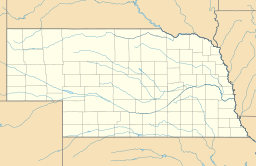Capitol Beach Lake facts for kids
Quick facts for kids Capitol Beach Lake |
|
|---|---|
| Salt Lake | |
| Location | Lancaster County, Nebraska |
| Coordinates | 40°49′30″N 96°44′28″W / 40.825°N 96.741°W |
| Type | lake |
| Surface area | 300 acres (120 ha) |
Capitol Beach Lake (also called Salt Lake) is a cool, private lake located in western Lincoln, Nebraska. It's about 300 acres (120 ha) big! The lake is looked after by the Capitol Beach Community Association, which helps keep it a great place for everyone.
Contents
What is Capitol Beach Lake Like?
Capitol Beach Lake is about three miles west of Downtown Lincoln. It's surrounded by homes where people live all year. There are also vacation homes and places to rent. From the lake, you can clearly see the Capitol Building. You can also see the tall buildings of Downtown Lincoln.
Fun Activities at the Lake
In the summer, there are lots of fun things to do at the lake! You can go swimming and boating. Many people enjoy sailing and fishing. If you like speed, you can try water-skiing or jet skiing.
Wildlife Around the Lake
The area around the lake is home to many animals. You might see blue herons and other waterfowl (birds that live near water). There are also minks, pheasants, deer, and foxes. These animals live near the lake and in the Saline Wetland Park. This park is managed by the Capitol Beach Community Association and the Lower Platte South Natural Resources District.
The lake itself doesn't have public beach access. But the Saline Wetland Park has nature trails. These trails are open to everyone. They are a great place to watch the different animals and birds.
How Did Capitol Beach Lake Form?
Ancient Salt Wetlands
Before Lincoln was settled, this area had many salty wetlands. These wetlands were fed by Salt Creek, a stream that flows into the Platte River. The ground in these wetlands was hard clay, covered with a white layer of pure salt. Small streams of very salty water flowed through them.
These wetlands were very important for the environment. They attracted lots of wildlife. People also came to the area to collect salt. The place that is now Capitol Beach Lake was the biggest of these salt basins. Many small streams met there.
Lincoln's Early Days
Before Lincoln became the state capital, only a small village called Lancaster was here. About 30 people lived there, mostly gathering salt. The idea of producing a lot of salt helped make Lancaster the state capital. People thought salt gathering could make it a very important business town.
At first, salt production was huge. One company made 125,000 pounds of salt in just one year (1866)! But people hoped to find a "mother lode" – a big underground source of salt. They drilled wells starting in 1869, but they never found it.
The saltiness of Salt Creek comes from ancient rocks from a time when the area was covered by an ocean. Salt Creek flows northeast, which is unusual for rivers in Nebraska. Once people realized there wasn't a huge salt source, Lincoln started growing eastward. It moved away from the salty, flood-prone Salt Creek and closer to fresh water.
From Salt Basin to Lake
In 1895, some clever business people built a wall (called a dike) at one end of the Salt Lake basin. They then moved a nearby stream called Oak Creek into it. This turned the temporary wetland into a permanent saltwater lake!
They turned the area into a resort called "Burlington Beach." It had fun things like steamboat rides, dance halls, bathhouses, and restaurants. A train line, the Burlington Railroad, brought visitors from Lincoln right to the beach.
The Lake Today
By 1906, the first owners sold the park. Not enough people were visiting because the dike had a leak, and the lake was losing water. The new owners renamed it "Capital Beach," which later became "Capitol Beach."
The city of Lincoln thought about buying the lake to make it a public park. But they decided not to. Some people were upset, saying the lake was a huge natural treasure for the city.
Until 1958, Capitol Beach was a private amusement park. It had a saltwater pool and a dance hall. But people started to worry that wetlands caused mosquitoes. So, in 1958, Salt Lake was drained. This happened so that Interstate 80 could be built through it. Later, parts of the lake were refilled with water from Oak Creek. This created Capitol Beach Lake and Oak Lake, which we see today.
In the 1990s, the Lower Platte South Natural Resources District began to bring back some of the original salty wetlands. This area is now the Saline Wetlands Nature Center. It's east of Capitol Beach and is open to the public. It's a great place to see these rare wetlands and the special plants and animals that live there.


